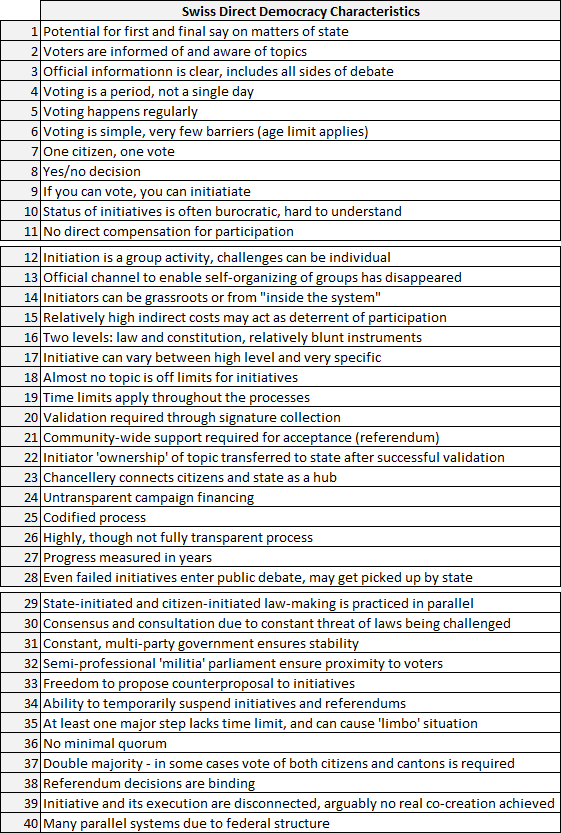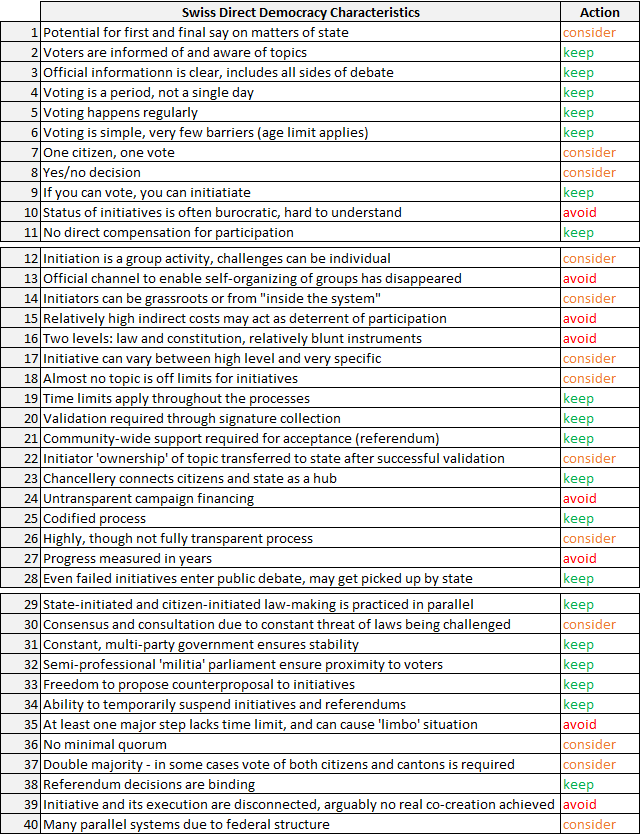After an introduction to this effort, a summary of co-creation literature, an analysis of Swiss Direct Democracy and its effects on society, it is time to answer the original goal of this undertaking:
What can organizations learn from the extreme involvement of constituents in Swiss Direct Democracy (SDD), and how can institutionalized co-creation be approached in service design?
As a first step in answering this, I’ll return to the key characteristics of Swiss Direct Democracy. I have listed these earlier, but below is a quick summary again:

As you will note, some items in this list seem positive, some seem negative, some seem neutral. But the context is important to note. What works in a democratic process to govern a country, might not work for an organization. So, how should characteristics in this list be approached, when rolling out such a process in an organization?
My proposal is to take one of 3 actions. On the one end, either strive to keep a characteristic. Or on the other end, aim to avoid a characteristic. Or, depending on your goals and organization type, you can consider a characteristic (noted, I might need to find a better verb for this – proposals welcome). This latter simply means that the characteristic may need fine-tuning, but the extent of this will change case-by-case.
Here’s the actions I propose to take (or not take) on characteristics, when considering their application in an organization:

Let’s take one example of each action.
- KEEP: #19 Time limits apply throughout the processes. Timeboxing works, and makes you more productive – don’t take my advice, read this Harvard Business Review article. Time-limitations apply both ways – to the organization and the participants, so it is a fair approach. And if you need a reason why to keep timeboxing, just look at the one part or the Swiss process where no time limit is applied: If an initiative succeeds, and thus the constitution is changed, a law should follow, to make the spirit of the constitution enforceable. But there is no time pressure on parliament to act on the change of the constitution. This has led some people to event doubt the effectiveness of SDD, as it leaves constitutional changes without consequences.
- AVOID: #27 Progress measured in years. The public sector changes at such a slow pace, that it would be unacceptable for a private organization. Actually, it’s often unacceptable for public organizations as well, but that’s a different story. While keeping time limits, clearly a shift in acceptable length of those time limits is needed.
- CONSIDER: #8 Yes/no decision. In Swiss referendums, people answer with either a yes, or a no. Simple, clear, to the point. But… how much value is lost with this kind of question. Service designers and researchers know that open ended questions produce much better outcomes. But of course, they are harder to base a decision on. A good reason why the simple yes/no answer option should be fine-tuned is that Switzerland itself is considering it. “Constructive Referendums” already exist on a cantonal level, and some argue for its introduction at the federal level – this would allow adding comments to a yes/no vote.
Of course organizations may review these characteristics, and themselves decide whether they are desirable for their specific circumstances or not. But the above list is a good starting point to roll out a co-creation process for an organization’s customers. What are the basics of such a process. The next post will dive into this.




















